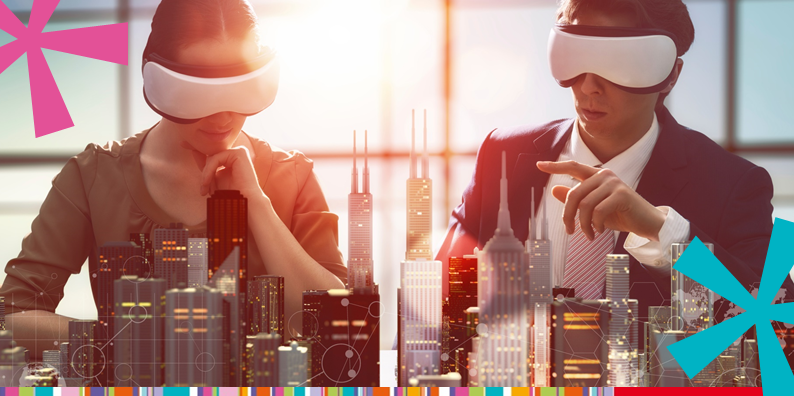Getting started with VR and AR driven learning - 3 killer questions answered
22/11/2016

Here are three key questions we can answer now for all learning professionals to make some progress and get to next steps.
1) What’s the difference?
Virtual Reality3D computer generated environments which can be explored and interacted with by a user, learner, gamer, manager, operator etc.Augmented RealityApplications that overlay virtual content on top of reality (either immediate reality / space like Pokémon GO or representation of a real space you can revisit – i.e. a ‘real’ office tour for a new employee)2) How can VR and AR be applied to my organization in learning solutions terms?
Virtual Reality- Learners are fully immerse in the virtual world
- Immersive learning means learners can be fully engaged with the learning material in an appropriate environment
- It enables kinesthetic learning and sensorimotor feedback (impacting both sensory and motor functions or pathways of the brain / nerve connections) – truly learning by doing, allowing users to interact with the system and environment, using their brain, body and movement, which in turn provides a greater sense of space and room to move.
- For example technical training like understanding how components work within machinery or critical pieces of kit. GE famously apply this kind of learning for their Jet Engine technical specialists who can enter a virtual jet engine, make changes through touch and manipulation of virtual components and understand the consequences, to derive learning for the real world application.
- Users remain in the real world and access instructional content that is CONTEXT SENSITIVE
- Excellent medium for induction training, introduction of teams / remote personnel, new role induction, function orientation, location tours, brand engagement and much, much more.
- This encourages on-demand learning and can foster a culture of personalized and continuous learning (particularly when used as an enhanced induction and organizational orientation learning method)
- Very practical drivign real-world learning with the immediacy required for today's on-demand, efficient learning requirements
3) What can we do to get started?
Here below is a summary visual for you with some key messages. Following that, you will find some tips, advice and next steps to take now, which will transform your learning solutions approach & delivery.
Virtual Reality - Getting started:
- Start with a single project – don’t try to create ‘whole world environments’ to start with. Experiment, apply, test and learn prior to applying to larger scale projects.
- Enhance your technical expertise or create a team of proven VR developers to short cut the trial and error. Be prepared for a steep learning curve again! Seek out online resources, videos and help blogs. Want to know more? Get some great tips from the team at Oculus here: https://developer3.oculus.com/documentation/intro-vr/latest/concepts/bp_intro/
- Consider technologies that are most appropriate to your organization, context and learning need
- Always be driven by the learning outcome, user experience and environment – in terms of learning efficiency and effectiveness of the learning medium
- Once you get started, you can create more complete RISK FREE learning environments to allow learners to experience the (virtual) consequences of their actions for critical job roles and target audiences. For example, health and safety training, process driven functions and job roles, compliance driven activity like company audit process and stages / requirements, warehouse stock checks etc.
- Enable the VR environment to allow learners to interact with each other (like multi-player gaming) driving peer sharing, collaboration and empowered learning discovery
Augmented Reality - Getting started:
- You can start at the speed of shopping!
- Buy your very own ‘Google Cardboard’ (It’s about $6) and looks like a cardboard box with two lenses on one end. It’s a traditional VR headset that is great for creating augmented reality solutions. Here is a simple video explaining how it works https://www.youtube.com/watch?v=SxAj2lyX4oU
- Next step…Download the “Cardboard Camera App” from your app store and install it
- Once you are ready to view, you put your mobile device inside and access specially shot videos (plenty on You Tube) to experience immediate augmented reality. For all you roller-coaster fans out there, try this one and observe how you feel when you view it through the GC glasses https://www.youtube.com/watch?v=p3VJAgcrSIA
- You can create your own augmented reality example very cheaply and even create your own business related ‘office tour’ by augmenting a series of panoramic photos. Here’s how. Try it and let me know how you get on:
1. Simply stand in the middle of your office and take as many photos moving around in a circle as you want, ensuring you capture floor to ceiling (vertically) as well as your circular (horizontal) journey.
2. Your Cardboard camera app then turns your series of pictures into an immersive 3D tour of your office, room, space etc.
3. Your possibilities are now endless and you are on your way to creating some augmented reality learning – even from this first example you can add context, photos of people and pop up text boxes announcing who is who, what department etc.
Other applications could include AR pocket cards for on the job performance support, simulation for high cost training (i.e. 4D modeling for technical training with expensive materials and suchlike), on-boarding and induction “experiences” to make the whole process more efficient and real-world effective for the learner / user. There is so much more you could do!Feel free to reach out for more information and help to get you and organization started on the path to virtual and augmented learning solutions:learn@cegos.com.sg